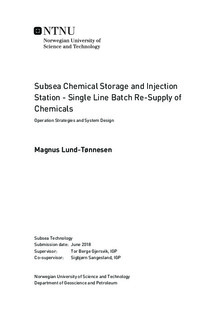Subsea Chemical Storage and Injection Station - Single Line Batch Re-Supply of Chemicals - Operation Strategies and System Design
Master thesis
Permanent lenke
http://hdl.handle.net/11250/2615113Utgivelsesdato
2018Metadata
Vis full innførselSamlinger
Sammendrag
The offshore industry is facing many challenges when it comes to maintaining operationalefficiency. One of the biggest problems is related to flow assurance problems.To avoid such issues, different chemicals are transported through individual lines in anumbilical from topside into a x-mass tree or a manifold. Total has for some years workedon a new concept where they want to replace the traditional umbilical with big tanks thatare stored on the seabed, which are refilled every sixth month. However, if it is possible tosimplify this, then the capital cost would be reduced even more.
The aim of this thesis was to look at the operational strategy, meaning how we cantransport these chemicals from one place top-side to a place subsea. Furthermore, find asolution for the design of the system, both regarding chemicals being into separate tanks, andtanks that contain a mixture of two or more of the chemicals, making a so-called chemicalscombination.
The approach used to answer the objectives of this thesis involves collecting relevantscientific reports and theory by search in scientific databases as well as books and otherrelevant sources online. Furthermore, calculations with focus on flow behaviour have beenconducted. Illustrations have been used to a large extent to illustrate flow behaviours inpipelines of different diameters, and when the liquid spacer are of different length. In addition flow diagrams have been sketched to illustrate the transportation and the distributionof the chemicals.
Due to the uncertainties on how the chemical will behave when they are sent throughthe same line, they will be separated by a liquid spacer. Uzu et al. (2000) say that theliquid spacer can vary from 100 meters to 500 meters depending on the size of the pipelineand the length it is going to travel. However, since there is little specific knowledge onhow long it should be between different chemicals, the liquid spacer has been seen as aparameter.
Based on the injection rates provided by Total for one field case, it was founded thatbiocide was injected at a much higher rate than the other production chemicals. It was,therefore, suggested that biocide should be injected every other time.
By sending the chemicals as combinations rather as individuals a tank module basedon the chemicals being sent through a 0,5 pipeline was reduced from 16 tanks down to10 tanks.
